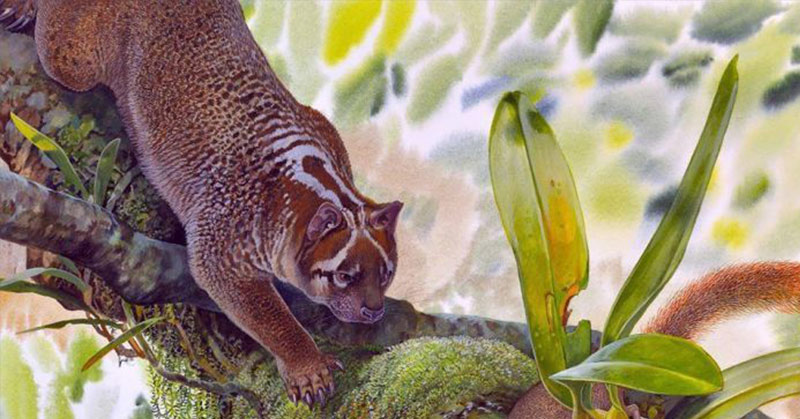Paleontologists found a partial animal skull at Australia’s Riversleigh World Heritage Area in Queensland, Australia. At first, the fossil was assumed to be a part of a group of marsupial lions that had died out about 35,000 years ago. Then they discovered it was an entirely new genus, which they called Lekaneleo roskellyae, or Leo for short. [1]
Leo is believed to have been roaming the earth 23 million years ago and was about the size of a house cat, minus the cuteness. Leo had teeth powerful enough to cut through flesh.
Michael Archer, co-author of a research paper along with University of New South Wales’ Anna Gillespie and Suzanne Hand, stated that this cat was part of “a strange group of marsupials. [2]
“This little guy that we’re calling Lekaneleo roskellyae… was one of the tiniest marsupial lions we’ve ever seen. It was actually like a pussy cat in size,” said the professor of biological, earth, and environmental science. “What we’ve progressively found at Riversleigh, where there’s been an amazing window of understanding about the evolution of this very strange group of marsupials, is that they started out as really tiny animals, smaller than a pussy cat.
“In Australia, the marsupial lions were the supremely specialized carnivores throughout at least the last 30 million years of Australian history. And this guy, this new one, we’ve only just recognized is highly different than any of the other previous ones we’ve seen. That’s why it’s been described now as a new genus of marsupial lion.“
What was Leo?
According to Dr. Archer, all of Riversleigh’s lions had distinct teeth structure.
“They had an extraordinary, elongated, bolt-cutting type of premolar,” he said. “This was the most extraordinary adaptation or evolution that a carnivorous mammal has ever developed anywhere in the world. It is capable of slicing straight through bones.”
Researchers believed that Leo lived in trees and ate birds, snakes, opossums, and even creatures as big as sheep. Although they are technically classified as “lions,” they are more related to kangaroos, koalas, and other marsupials (“pouched mammals”). Don’t be fooled by Leo’s small frame; there’s no way it would play with a ball of yarn and snuggle on a throw rug. [3]
“I would think that many of the animals in the Riversleigh ancient rainforest would have been shaking in their little furry boots when they saw this animal come along,” said Dr. Archer. “We don’t have any living animals today to tell us what these animals may have been doing. These forests were ever so much more complex than anything you may see now in the wet tropics.
“It makes us understand that the total effect that has happened in Australia is a steady loss of the complexities that was normal in the forests in Australia.”
The Secrets of Riversleigh
Riversleigh is a famous archeological site, and Dr. Archer has been working hard at for the last 40 years. He has found that the bio-diversity in Australia during that time was on a much higher level than it is today. Extinct species like Leo can teach us how climate change may affect animals today.
“We see over time, as climates have changed, as the rainforests have retreated to the edges of the continent, the biodiversity of Australia has steadily shrunk,” said Dr. Archer.
Riversleigh is a gateway to the past and Dr. Archer believes that it can also teach us about the future. For example, Riversleigh had experienced, at one point in history, a two-degree temperature rise that caused the deaths of about 50% of species living there.
“There is a message here of course and it’s that if we keep allowing the Earth’s temperature to rise, we are going to see a massive loss of biodiversity,” Dr. Archer said. “When you think about what’s in the wet tropics… and you subtract every second kind of animal in those forests, you begin to understand how significant those losses are going to be.
“That’s what the fossil record enables us to do. We’re not confined to just guessing what’s likely to happen as global temperatures rise, we’ve actually got a fossil record at Riversleigh that tells us what happened when this happened before.
“In that particular case [about 15 million years ago] … we did watch massive losses of species. But then we did watch, over hundreds of thousands of years, the species’ diversity pick up again when the global temperature started to drop.” [4]
Keep Reading: When Researchers Discovered an Underwater Volcanic Range it was Teeming With New Scary-looking Fish Species
- BBC. Ancient marsupial lion fossil discovered in Queensland. News Round. https://www.bbc.co.uk/newsround/51702965 MArch 2, 2020
- University of New South Wales. Lekaneleo, a new genus of marsupial lion (Marsupialia, Thylacoleonidae) from the Oligocene–Miocene of Australia, and the craniodental morphology of L. roskellyae, comb. Nov. Journal of Vertebrate Paleontology. https://www.tandfonline.com/doi/abs/10.1080/02724634.2019.1703722 February 19, 2020
- Amy Woodyatt. This tiny lion with teeth like bolt-cutters once roamed Australia. CNN. https://edition.cnn.com/2020/02/28/australia/marsupial-lion-australia-intl-scli-scn/index.html February 28, 2020
- Kelly Butterworth. Email New genus of Australian lion discovered in Queensland’s Riversleigh World Heritage fossil site. ABC News. https://www.abc.net.au/news/2020-02-28/australian-lion-discovered-in-outback-queensland/12007324 February 28, 2020

